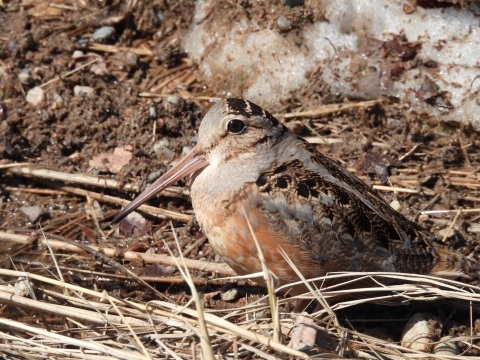Ever heard of the American woodcock? No? What about the Timberdoodle? Bogsucker? Labrador Twister?... Mudbat??
If you didn’t already know, all of these names refer to one species of bird. Officially known as the American woodcock (Scolopax minor), this bird-of-many-names earned its titles over time. Different nicknames evolved from different regions, based on the bird’s behavior and physical features.
What initially appears as a funky little brown bird becomes a creature of charm, quirkiness, and enchantment upon closer inspection. From their adorable “peent” calls to their groovy dance moves, the American woodcock beguiles all who encounter it.
Identifying Features
The American woodcock is a compact, stocky bird with several distinguishing characteristics. The adult woodcock measures about 8 to 10 inches in length and has a wingspan ranging from 18 to 24 inches. It is primarily brown, with intricate patterns of gray, black, and rust that help it blend seamlessly into its forest floor habitats.
One of the most notable features of the woodcock is its long, straight bill which measures up to three inches long. This bill is perfectly adapted for probing the soft ground for earthworms and other invertebrates, which make up a significant part of its diet. Its large, round eyes are positioned high on its head, allowing it to have a wide field of vision to spot predators.
Where can I see an American woodcock?
The American woodcock typically resides in the eastern United States, especially in areas with moist woods, fields, and wetlands. In the Southeast, several National Wildlife Refuges provide valuable habitat for this elusive bird. Some notable refuges include:
- Santee National Wildlife Refuge (South Carolina): This refuge offers an ideal mix of open fields and forested areas, making it a prime spot to observe woodcocks, especially during their breeding season.
- Alligator River National Wildlife Refuge (North Carolina): Known for its wetlands and vast expanses of forest, this refuge attracts many woodcocks throughout the year, particularly in fall and winter.
- Great Dismal Swamp National Wildlife Refuge (Virginia and North Carolina): This expansive refuge provides the lowland habitats that woodcocks prefer, allowing for some excellent birdwatching opportunities.
- Big Branch Marsh National Wildlife Refuge (Louisiana): With its rich marshlands and forested patches, this refuge is another great location for spotting these captivating birds.
What makes this bird so special?
The American woodcock is not only remarkable for its unique appearance, but also for its fascinating behaviors and habitat preferences. One of the most endearing traits of the woodcock is its elaborate courtship display. Male woodcocks perform a distinctive "sky dance" during the breeding season, which involves ascending into the air while producing a series of peent calls, followed by a graceful descent that leaves observers enchanted.
Even if you’ve never seen a woodcock in person, you’ve probably seen a viral video of it. In addition to its fancy courtship displays, it also has quite a strut. It is believed that the American woodcock does a little dancey-dance in order to rustle up some delicious underground grub. This theory is not confirmed, but it is proof that it definitely puts its best foot forward.
We've got to give points for adaptability and resilience, as well. This bird thrives in different habitats, from young forests to open fields, and is excellent at avoiding predators with its cryptic coloration and effective camouflage.
Whether you're an avid birder or a casual nature enthusiast, seeking out this remarkable species in its southeastern refuges is sure to provide a memorable experience.
American Woodcock Photo Contest
As part of our Bird of the Month series, we invite you to submit your photos of American woodcocks in a photo contest.
**In the file name of your photo, please include your first and last name, contact email address, and the location where the photo was taken. If these components are missing, we will have no way of contacting you if you win.**
Submit Your Photos Here
Submissions will be judged by a panel of U.S. Fish and Wildlife Service employees. Once a winner is selected, they will be contacted via email and asked to sign a photo release form. This form protects the photographer's rights, ensures proper credits are given, and grants the U.S. Fish and Wildlife Service permission to share the photo on our social media channels. Please monitor your junk/spam folders towards the end of the month in the event that we reach out and our email lands there.
The winner will be announced publicly near the end of each month on our Southeast Regional Facebook and X (formerly known as Twitter) platforms.
A photo contest will occur each month for each featured bird species. At the end of 2025, all twelve winning photographs will be shared on our regional social media accounts.






